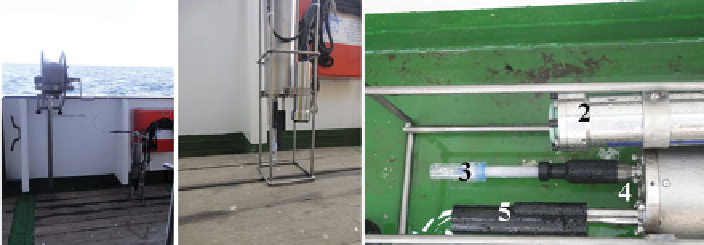Civil Engineering Reference
In-Depth Information
Fig. 9.6 Winch and CTD probe (
left
) and sensing elements (
middle
and
right
). Number through
images: (
1
) data transfer and power supply cable and connection and rope of winch, (
2
) oxygen
sensor, (
3
) temperature probe, (
4
) pressure sensor, (
5
) conductivity cell
10
6
parts of
the resistance value must be resolved. Therefore, Pt100 is used as resistance within
a Wheatstone bridge circuit.
This means that, connected with small temperature coefficient, 2.5
Conductivity Measurement
The used technique for conductivity is a galvanic method with two electrodes via a
bridge circuit. The electrodes are sensitive against exterior electrical and magnetic
fields. They have to be protected towards outside then the surrounding cannot take
an influence on the measuring signal.
Pressure Measurements
Pressure measurements with electrical technique are done by diaphragm capsule.
The bending of a membrane determined the measurement. The bending is gathered
piezoresistive.
In sum, 42 CTD profiles at different positions were taken by cranking the CTD
probe from sea surface to bottom and back during the WEGA cruise 141 on
12 May 2013.
9.1.3 ADCP
Figure
9.7
shows the instrument ADCP (acoustic Doppler current profiler) with it is
four sensors and construction for placement at sea ground. The ADCP is fixed
within a ground track, which again is connected to some weight via a cable to make
sure that the rack will be placed at ground. The connected buoys are swimming at
surface and mark the position of dropped ADCP.
ADCPs are used to measure how fast water is moving across an entire water
column, that is, water velocity over a profile. The water currents are measured via
sound considering the Doppler effect. The ADCP transmits pings of sound at a
constant frequency into the water from bottom to surface. As the sound waves

Search WWH ::

Custom Search